The Saracen Head.
209 Gallowgate, Calton, Glasgow. Tel: 01415520370.
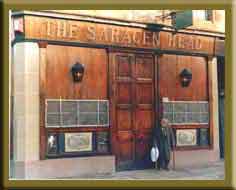
The Saracen Head. 1991.
To read the full history of this historic landmark click here.
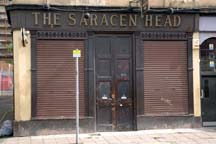
The Saracen Head, August 2005.
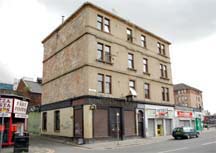
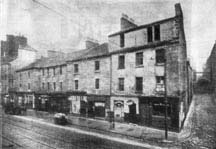
Other view's of the old Saracen Head Inn, this one was taken just before it was demolished, the right hand side of this photograph at the corner of Saracen Lane is a public house, owned by Mrs McPhail.
In October 1773 Dr Samuel Johnstone and Mr James Boswell returned to Glasgow from their tour of the Hebrides. They put up at the Saracen Head Inn, Gallowgate and this is what Boswell wrote; " On our arrival accounts from home, and Dr Johnston, who had not received a single letter since we left Aberdeen, found here a great many, the perusal of which entertained him much. He enjoyed in imagination the comforts which we could now command, and seemed to be in high glee. I remember he put a leg up on each side of the grate, and said, which a mock solemnity, by way of soliloquy, but bud enough for one to hear it; there am I, an Englishman, sitting by a coal fire. On Friday, October 29, the professors of the University being informed of our arrival, Dr Stevenson, Dr Reid and Mr Anderson breakfasted with us. Mr Anderson accompanied us while Dr Johnston viewed this beautiful City."
Professor Reid and Anderson and the two messieurs Foulic, "the Elzevirs of Glasgow," dined and drank tea with us at our inn. Boswell and Johnston left the Saracen Head Inn the following day and went to Ayrshire. There is a story that Dr Johnston and Adam Smith has a night's drink at the Saracen Head Inn and their discussion ended in a swearing match. The very bowl they drank their punch at the Saracen Head inn was produced at a meeting of the Old Glasgow Club in October 1904.
Robert Burns and John Wesley, two rather different types took rooms there. In the summer of 1803. William Wordsworth and his sister Dorothy arrived, along with Samuel Coleridge. They stayed for two days and admired Glasgow greatly. The hackney coach in which they arrived was the first ever seen in the city and when they left to travel west-wards a crowd of small boys followed the coach cheering and shouting, for several miles.
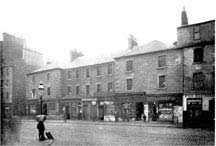
Another view of the old Saracen Head Inn, part's of the old inn have now been converted into shop's.
On 24th November 1754, therefore they sold the land of the Kirkyard of little Saint Mungo on the north side of the Gallowgate to Robert Tennent the owner of the White Hart Inn with provisions that he should erect a first-class inn on the site according to an agreed plan.
The Glasgow Courant for October 1755, the proprietor Robert Tennent, was careful to stress the modern comforts of the 36 room Inn: The bed-chambers are all separate, none of them entering through another, and so contrived that there is no need to going out doors to get to them. The beds are all very good clean and free from bugs.
Robert Tennent took the oppertunity to acquaint all ladies and gentlemen that the desire of the magistrates of Glasgow. He had built a convercent and handsome new Inn, agreable to a plan given to him. The Inn containing 36 fire-rooms was now fit to recive lodgers. The bed chambers are all separate, none of them entering through another. The beds are all very good, clean and free from bugs.
When the Inn was finished in 1755 it had stables for 60 horses and offices at the rear of the premises. There was a pump well in the yard which was thought to be the well created for the use of the chapel of Little St Mungo, when it was founded in 1500. A central broad flight of steps led to the Inn's main entrance hall.
Coach's left the Saracen Head Inn at 9 in the morning for Edinburgh and at any other hour that the first 2 passengers might agree on and that for Ayr at 10 oclock forenoon.
The Inn became known as one of the most spacious and elegant in Scotland. Merchant's daughters were sent for lessons in the culinary arts, each paying the head chef 5 shillings to see how the different dishes were prepared and served up. At one great country dinner the appearance of 15 or 16 elegant young cooks with white aprons placing the dishes on the dinner table made such an impression on the gentlemen present that the younger and more sprightly county gentlemen immediately set about joking and flirting with these handsome cooks, and were greatly more entertained by this sport than with their dinner, for some of them went down to the kitchen and assisted the young ladies to hand up the dishes.
Dougal Graham, the skellat Bellman of Glasgow, was often seen about the Saracen Head Inn. He was lame, a hunchback, and a poet. He wrote several chapbooks which had a great sale for those days. He was appointed bellman about 1770, after a competition in which dozens of bellmen took part. The magistrates apparently picked Dougal because of his unusual appearance, his peculiar way of ringing the bell and his fine loud voice. For his test he cried in Stentorian Tones:
"Caller herring at the Broomielaw, Three a penny, three a penny!" Then he added: "Indeed, my friends, But it's a blowflim, For the herring's no catch's, And the boat's no' come."
What Glasgow Magistrates could resist such wit?
One day in 1776 some officers newly returned from American War were looking out of one of the windows of the Saracen Head Inn, when the Hunchback bellman come along, one officer shouted rudely, "What's that on your back, Dougal? Dougal Graham just looked up and replied: "it's Bunker Hill. Do you care to much?"
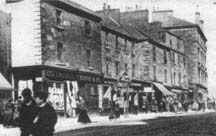
An old postcard view of the Saracen Head Inn with the new Saracen Head building in the back ground.
When other good hotels were built in Glasgow and the city moved west, the Saracen Head Inn fell on evil days, latterly it was turned into tenements and became a very seedy building. Before it was demolished the Old Glasgow Club met in the Great Dovehill mission hall, which in its palmy days, had been the Assembly Room of the Saracen Head Inn. The club members were able to mark out the Fiddlers Bank; a jort of minstrels' gallery, where the famous Neil Gow among others, had played. On display was the great punch-bowl of the Saracen Head made to hold five gallons. On the bottom of the bowl is a fancy description of Glasgow:
In 1791 William Miller of Slatefield purchased the Inn and converted it to shops and houses, he also built an addition to the east. For about 50 years the ball-room was used as a place of worship by various sects, after which it became a reading school.
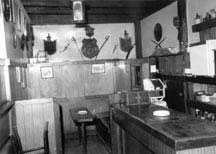
Interior view of the Saracen Head before alterations. 1990.

Interior of the Bar 1990.
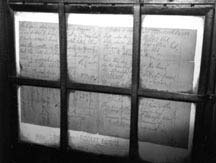
An old poem written by Rabbie Burns in 1795 guarded by bars and hard glass. It as now sadly disappeared from the bar, and is supposed to be in the owners safe hands.
In 1892 the Authorities had a family evicted in Saracen Lane, for their involvement in the making of an illegal still and using their house as a shebeen, after their house was raided, everyone was arrested, the outcome was heavy fines and their home had been condemned, the tenants were told to seek pastures new.
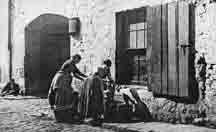
These ladies were washing clothes outside the Saracen Head Inn, the archway in the background was the carriage entry to the Ballroom.
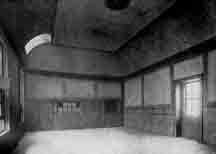
The old Ballroom, assembly room. 1900.
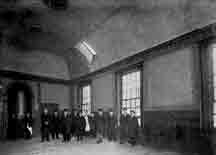
Another view of the Assembly room. 1900.
The old well at the rear was restored in 1906, a charming Iron Fountain which was made by the Saracen Foundry in Possilpark. There was another building at the back an Elizabethan type building, now demolished. It was put up by one of the Anderson's of John Anderson's Royal Polytechnic as a boy's club. It served various functions, including for a time that of a film studio.
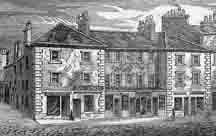
An old Etch of The Saracen Head Inn with shops on the ground floor.
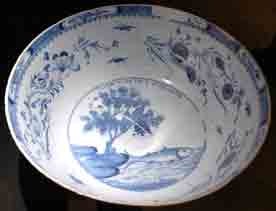
The Saracen Head punch bowl.
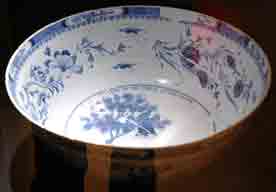
This Punch bowl was made by the Delftfield Pottery Company in Glasgow in the 1760s. It was made for the Saracen Head Inn. Punch is a drink from mixing different alcoholic drinks and fruit juices.
The Delftfield Pottery Company was set up in 1748 near the Broomielaw on the River Clyde. Here the potters made tin-glazed earthenware known as delft-ware. Delft is a town in Holland where this type of pottery was first developed at the end of the 17th century. The Dutch potters got their ideas from China.
Much of the delft-ware made in Glasgow was sent to the American colonies to meet the demand of the settlers for good quality china. One of the first share-holders in the company was Robert Dinwiddie who later became Governor of Virginia where much of the pottery was sent.
The punch bowl had been broken and repaired may times perhaps during a heavy drinking session! Last century it was repaired using plaster, cement and metal rivets to hold it together. Its many rivets were corroding and causing damage to the bowl, they were recently removed. The bowl is now held together with a safe and completely reversible adhesive.
On the site of the Saracen Head Inn, and just outside the city Port, stood the chapel called Little Saint Mungo's, surrounded by a burying ground. It was founded some time before 1500 by David Cunningham, archdeacon of Argyll. In a deed granted by him in that year, endowing the chapel, he describes it as "unam capel-" Lianam cum.
After the reformation it became the property of Donald Cunningham of Aikenbar and Marion Lyon, his wife, from whom it was purchased by the Magistrates in 1593 at the price of 200 merks- £13, 6s. 8d according to the value of Scots money at that time. On the condition that the "Chapell, hous, and yaird were to be maintained as an hospital for the poor. The Magistrates did convert it into an hospital for lepers, and for some time maintained it as such; but in breach of their trust, they converted it about the middle of 1700s to Robert Tennent for the purpose of his building on it a first-class hotel, which he did. This was the Saracen Head Inn.
Even so late as 1737, when McUre (Glasgow Historian) wrote his history, the Gallowgate extended no further than the East Port. Beyond that was only a narrow country road, chiefly between hedges, leading to the old village of Camlachie. Between that Port and Glasgow Cross, and not far from the old chapel, the street was crossed by the Molendinar Burn, like St Enoch's Burn, it crossed on the surface, and there was a considerable decent to it on each side, with stepping stones in the stream for foot passengers. When it was swollen by rain, people had to cross in carts or on horse-back. The burn was a favourite place for watering horses and cattle, and Dr Buchanan, writing in 1856, says he had conversed with old people who remember it in that state. Now a foul underground sewer, it was then a clear limpid stream. In the Glasgow Courant for 1755 there is an advertisement of a piece of ground at the Spoutmouth to be let and one of the inducements held out to a tenent is its vicinity to the Molendinar as suitable for bleaching.
Besides the trees of St Kentigern in the foundation of Little St Mungo's church, there was near the same place a well, called St Mungo's well- fons Kentigerni.
The Plan of Little St. Mungo's Chapel was built in Octobert 1500. The chapel was erected just beyond the Gallowgate Port (or Gate) near "the trees of St. Kentigern," a small wood. It was surrounded by a cemetery and there was a well in the grounds (referred to in 1558 as "Saint Mungo's Spoutis") that was reputed to contain water of a very high purity.
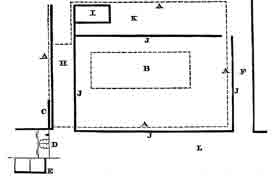
Ground Plan of Little Saint Mungo's Chapel.
Lands of Dovehill, partly covered of old with trees.
A.A.A.A. Dotted Lines. Supposed line of Church-Yard Dyke.
B. Little St Mungo's Chapel, surrounded by Burying Ground.
C. A small piece of wall remaining in a close.
D. East Port, taken down by Provost Cochrane in 1749.
E. Old Houses. (No. 182 Gallowgate,) against which the south end of the port rested. The north end of the port joined the south end of the Kirk-Yard Dyke; and where Dovehill was opened the west part of the old dyke was allowed to remain until houses were built along its line.
F. Saracen's Lane, or Brass Bell Lane. An ancient thoroughfare to the north,- supposed to be the Priests' Road to the Cathedral; amplified when the Saracen's Head Inn was built, as a private Entry to the Stables. This road went along the east side of the old Kirk-Yard Dyke.
H. Great Dovehill. The west side of the old Kirk-Yard. This was the carriage Entry to the Ball-Room, &c., marked.
I. Ball-Room of the Saracen's Head Inn.
J.J.J.J. Indicate the area occupied by the Saracen's Head Inn, built within the ancient Kirk-Yard, and partly on the site or the Chapel. The frontage to the road or Gallowgate was 100 feet.
K. Court Yard of the inn.
L. Gallowgate to Camlachie.
Like many of the old Saints, Kentigern is said to have had his bed, his bath and his chair. The bed, Jocelin tells us, was hollowed out of rock. He bathed in the Molendinar, and his seat, according to an ancient tradition, was "Super Lapidem in Supercilio Montis Vocabulo Gweleth." Gweleth, forming in combination Wleth, signifies dew, and hence, it has been said, the hill was called Dew Hill, converted afterwards into the present name Dowhill or Dovehill.
The Gallowgate ended in a common called the Gallowmuir. The place of execution was there, and till near the end of the 1700s, the Gallows- which gave their names to the North West end of the Common, near the upper corner of what is now Barrack Street. Extended east from the Butts (afterwards the Barracks) to Camlachie, bounded on the north by the Carntyne Road, once a Roman "iter," and on the south by what is now Calton. The muir was a wild common, overgrown with whins. Whitevale, Annfield, Bellfield, Slatefield, Campbellfield, Jeanfield, and other villas were built on Gallowmuir. Annfield was built by Tennent, who called it after his wife, Ann Park. The memory of Ann, Bell, Campbell, Jane and Slate-field are preserved still (1894) in the names of streets in the locality. Burgh Records, 21st May 1625-"Ordaines the Master of Work to repair the buttis in the Gallowmuir for exercis of schutting quha pleisses."
The Gallowgate Port was taken down in 1749.
Email from Robert Douglas...
I wondered if in your researches you had come across any references to my grandfather Hamilton aka Joseph Douglas who was born in the East End of Glasgow. I attach my life line for him, emboldening those parts which are relevant to your research on shebeening and running illict stills.
never met my grandfather, and my late father, also a Joseph Douglas, never saw him again once he was taken into care, following the fourth imprisonment and lived with foster parents in Kiltarlity near Inverness. In the parish record relating to the fostering my grandfather was described as guilty of shebeening.
In the past few years I have managed to piece some material together, through visits to the National Archives and the Mitchell Library. It is possible however you know more than me! I have copies of the relevant Glasgow Herald and Evening Times articles, but not the Eastern Standard. Do you know where copies of this paper still exist?
Sadly, the only known photograph of my grandfather was in a wallet stolen from my dad when he worked in a London pub as a youth. He thereafter lived most of his life in Corby, which is where I was born and live. (Little Scotland!)
Although I have no evidence, my dad used to reckon that my grandfather got the idea of making a still as a result of being an orra man in the Saracen’s Head. Apparently, being a tin or coppersmith he was asked to repair "something" there. One wonders what the something was. About 20 years ago I took my dad on a sentimental walk along Gallowgate and the Dalmarnock Road and we met Wee Angus in the Saracen’s head, who reckoned as a wee boy he remembered a Douglas fixing things. So there may be substance in the story.
My grandfather’s spirit was distilled from the spent barley handed out apparently free to the poor by Tennents in Duke Street. It was his contention it was not completely spent and of course he was correct. My dad remembered ferrying the liquor on trams to distant points and calling at the back doors of bars where the Douglas spirit was purchased and apparently mixed with proper whisky by the landlords.
To read more on the pubs on the Gallowgate read up & Doon the Gallowgate by John Gorevan. A copy can be bought for a few pounds at the Hielan Jessie on the Gallowgate or contact me at john@oldglasgowpubs.co.uk
End.
